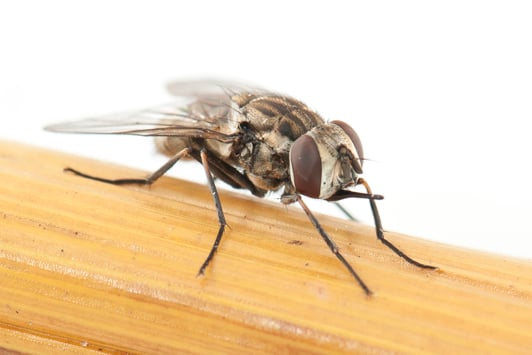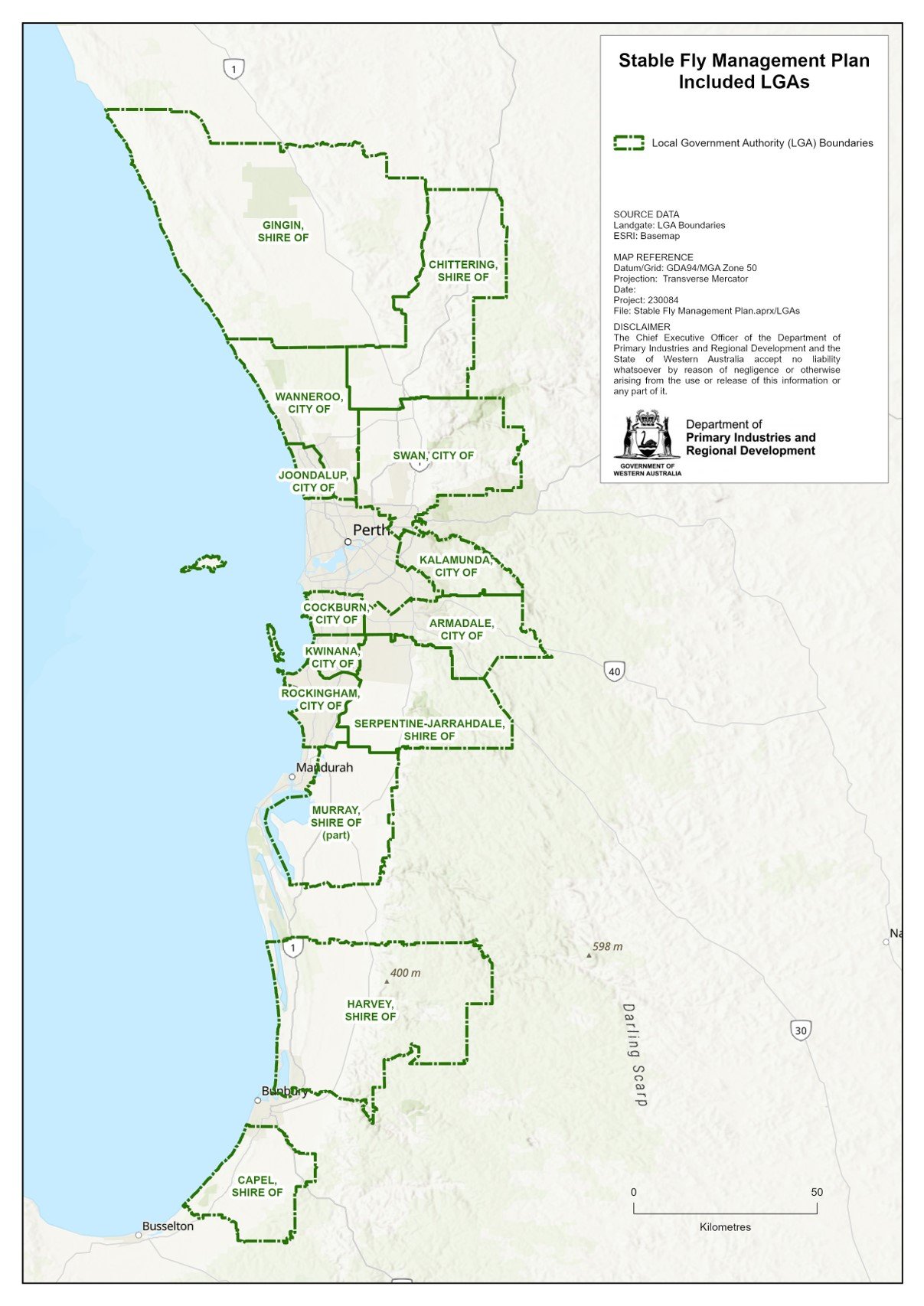Stable fly (Stomoxys calcitrans) is a blood feeding parasitic nuisance fly with a painful bite that causes pain and distress to people, pets and grazing animals.
Stable flies (also known as biting house flies, barn flies or power mower flies) breed in moist organic material such as manure, compost, grass clippings, and vegetable waste. They can travel to surrounding areas up to 20 km away and use their razor-sharp mouth to shred the skin and draw the blood of cattle, sheep and horses, people and pets. The pain and distress to the animals can result in animal welfare issues and production losses in commercial livestock.
They are a problem in Perth, Western Australia because the Swan Coastal Plain provides perfect conditions (sandy soils, temperate climate, rotting organic material and nearby hosts) for stable fly to breed in high numbers.
Infestations can limit recreational activities, outdoor work and impact our psychological wellbeing.
Stable fly management – a shared responsibility
Stable fly is a declared pest for 14 local government areas in Western Australia, effective management requires cooperation between landholders, local government authorities (LGAs) and the Department of Primary Industries and Regional Development. The department is working with horticultural industries, landholders, LGAs and affected communities to reduce stable fly breeding.
- Under the Biosecurity Agricultural Management Act (2007) (BAM Act), landholders are responsible for managing declared pests on their land. If you are a primary producer, landowner or resident in these areas, it is your responsibility under the Act to manage stable fly using the control measures in the Stable Fly Management Plan 2019. The stable fly management FAQs provide more information on these control measures.
- The department supports LGAs by offering comprehensive training and appointment of inspector powers under the Act, technical advice, and compliance assistance when required.
- LGAs who have nominated employees to be appointed as Inspectors under the Biosecurity and Agriculture Management Act 2007 (BAM Act) have the authority to inspect properties, provide advice to landholders to mitigate stable fly breeding, and follow up on compliance.
The department encourages all LGAs to participate in this shared approach to protect our community and livestock.
If you report stable fly infestations to your LGA, please note that action depends on your local government's involvement.
You may not realise that stable flies are breeding in the rotting organic material on your property because once the stable fly emerges from its pupae, it flies off in search of a blood feed on neighbouring properties.
Declared pest
If you are located in an area where the stable fly is a declared pest, you must follow the control measures contained in the Stable Fly Biosecurity and Agriculture Management plan.
Controlling organic waste is critical to reducing the impact of stable fly in our communities
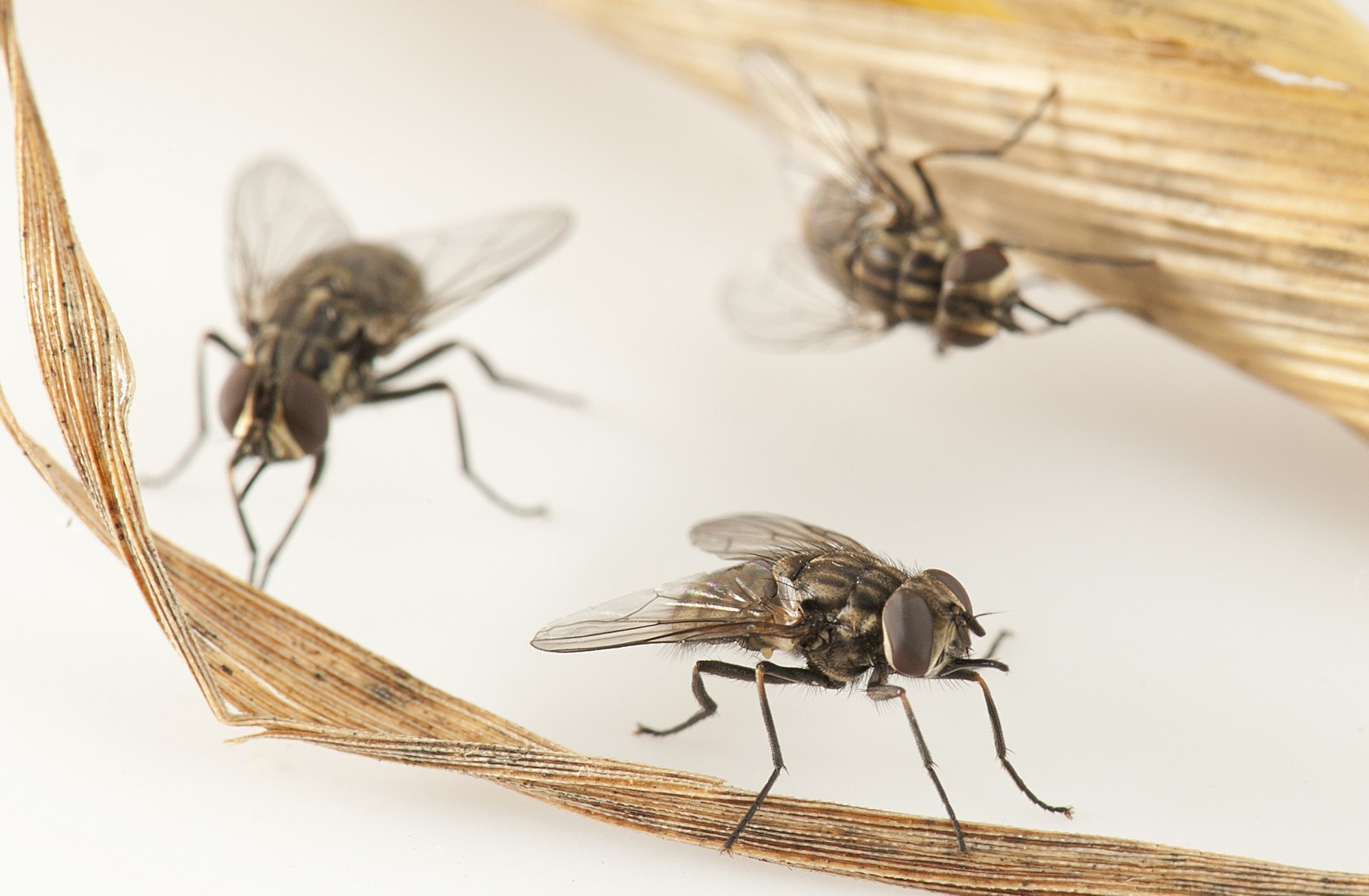
Reporting and compliance
Reporting - if you are experiencing problems with stable flies, please report this to your local government authority.
Compliance - it is each landholder's biosecurity obligation to manage declared pests such as stable fly on their property (Biosecurity and Agriculture Management Act 2007).
Horticultural industry and vegetable growers
Market gardens on the Swan Coastal Plain can provide an ideal environment for stable fly. You can help to protect surrounding communities and livestock from the fly’s painful bites by managing rotting organic matter to reduce the number of breeding sites on your property.
If stable fly breeding sites are not managed, this may lead to conflict with neighbours and production losses in commercial livestock. Stable flies can travel up to 20 km to feed on cattle, sheep, horses, and people and their pets.
Why early detection matters
- Prevent outbreaks: Stable flies breed rapidly in decaying organic matter. Detecting larvae early allows you to remove breeding sites before populations explode.
- Protect livestock health: Stable flies are aggressive biters, causing stress, reduced weight gain, and lower milk production in cattle.
- Reduce chemical reliance: Physical removal of breeding sites minimises the need for insecticides, saving costs and reducing environmental impact.
- Improve farm hygiene: Regular monitoring and cleanup of rotting vegetable matter and manure helps maintain a healthier environment for crops and animals.
See the stable fly FAQs and management strategy documents for further information.
By implementing responsible control measures on your property throughout your crop lifecycle you can protect your workers and neighbours from stable fly bites.
Weekly monitoring:
- Check for evidence of stable fly breeding (larvae or pupae) in all potential sources. If found, use an approved pesticide or bury the organic material to a depth of 1 m.
After the crop matures there are several options to reduce stable fly breeding sites:
- Turn off irrigation (stable flies cannot breed in dry soil).
- Harvest as soon as possible including unsaleable items – waste material that (stumps, stalks, leaves) makes a perfect environment for stable fly to breed.
- Deep burial. Bury waste material at least 1 m deep to prevent fly emergence, or
- Mulch and desiccate. If large pieces of waste remain on or in the soil (root stumps), use a high-speed mulcher, then leave the waste to desiccate, or
- Cultivate the soil and waste on consecutive days for at least a week to expose the eggs and larvae to the sun, especially where the waste and soil have become compressed by wheel ruts. Check continually for larvae in these areas (moist and compressed).
- If larvae are present after this regime use an appropriate and approved pesticide.
After rain in the warmer months, monitor for the presence of larvae and pupae and use a pesticide treatment if larvae are detected.
Reject produce can be managed by:
- Feeding out to livestock in thin lines, in a feed trough or on hard surface (to avoid mixing with soil).
- Deep burial at least 1 m below the surface.
For additional information download our effective management strategies, which is also available Vietnamese.
If your horticulture enterprise is located in an area where the stable fly is a declared pest, you must follow the control measures contained in the Stable Fly Biosecurity and Agriculture Management plan. You can also find additional resources to assist growers in the documents section.
Information for livestock owners
Stable fly is closely associated with human activity and can be a serious pest of livestock around animal enclosures, stables, feedlots and paddocks or pastures.
The fly will make several attempts to feed, adding to the animal’s distress. Once settled on an animal, it takes 2 to 5 minutes to complete the blood meal, before seeking a shady place to digest it.
Cattle and horses are most affected. Animals will try to avoid the fly by stamping their feet, tail switching, throwing their heads down toward their front legs, and kicking sand up onto their legs and body. In large stable fly numbers, cattle will often bunch together to get to the centre of the group to avoid the flies, or they may stand in open water to avoid being bitten.
When large numbers of stable fly are present (as few as 10 per animal) they impact the animal’s ability to feed and care for itself. The constant movement of animals due to the agitation of the flies can lead to stress, dehydration, and weight loss.
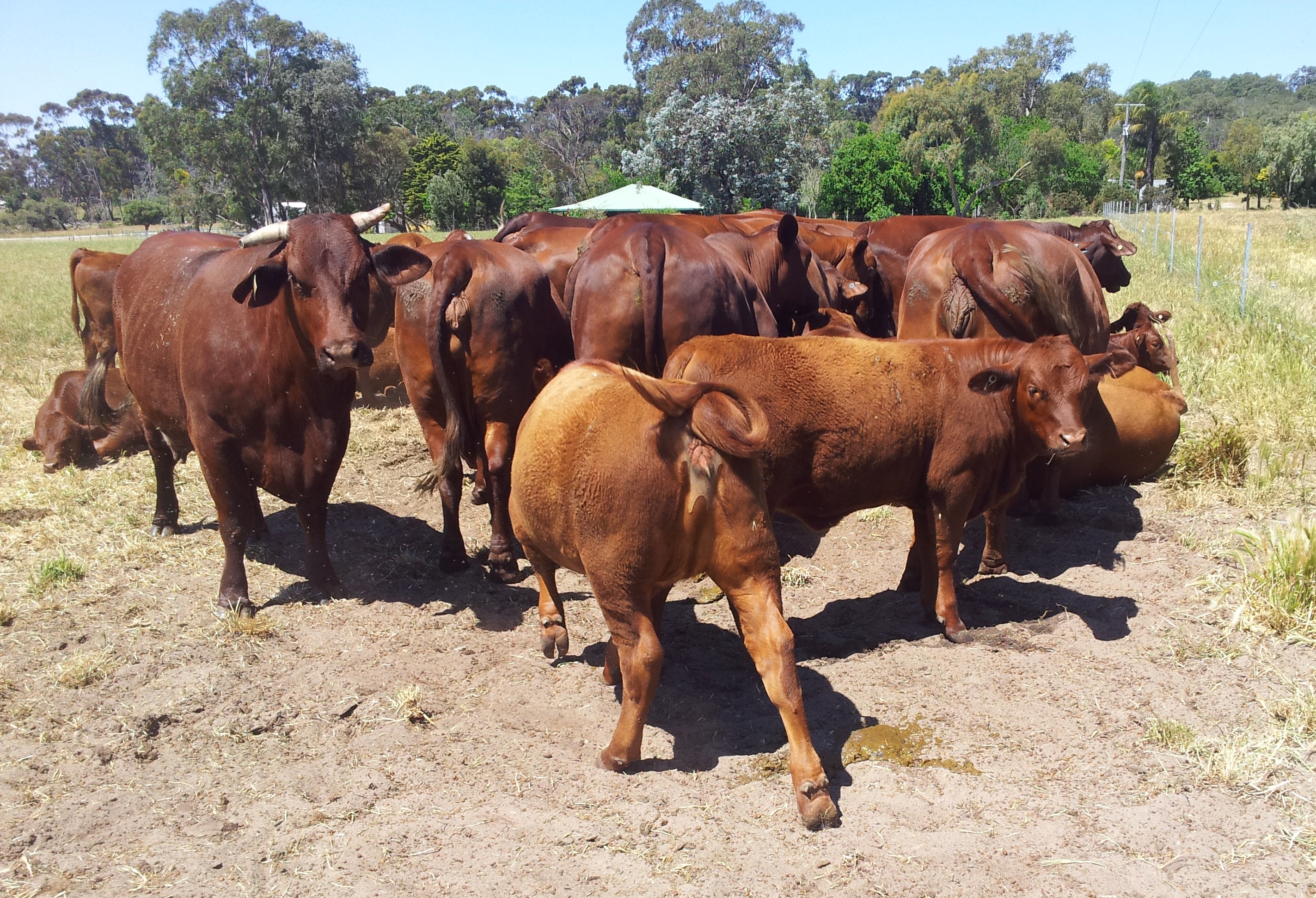
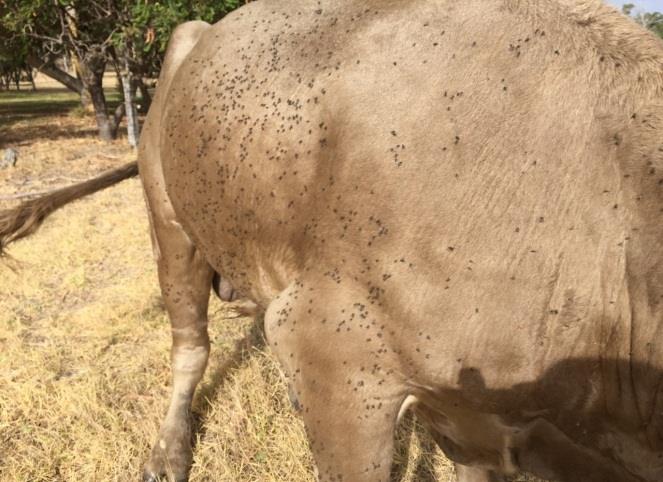
Photo: Cattle bunch together when stable fly bite them
When to report to your local government authority
Report stable fly infestations to your LGA when the animals are showing avoidance behaviours that prevent them from grazing, drinking and caring for their young.
Outbreaks of stable fly have forced cattle and horse owners to relocate their animals away from affected areas.
Controlling organic waste is critical to reducing the impact of stable fly. To ensure that there are no breeding sites on your property, include these regular hygiene practices into your biosecurity plan:
- Feed vegetables to livestock in long thin lines, in a trough or box to prevent mixing with the soil.
- Regularly remove accumulated spilled grain feed and organic material in pens and yards.
- Weekly removal of animal manure and soiled straw accumulating in pens and yards, around water troughs and under fences, and gates.
- Stockpile animal manure for short periods (less than 3 days) before covering with plastic to protect them from getting wet.
- Cover animal feed and bedding waste with a fly-proof barrier and keep it completely dry with a tarp or plastic sheet.
- Spread animal manure and grass clippings into thin layers on the ground to dry out.
Note, hay that has been fed to animals, trampled into the soil, mixed with manure and urine, and exposed to the weather will take months to break down and may become a stable fly breeding ground. In this situation, hay must be either deep buried or sprayed with a pesticide and left undisturbed to allow emerging flies to contact the chemical residue/barrier. Spreading out this hay thinly will not kill the larvae. - Bury waste organic material (reject vegetable produce, manure, animal bedding, feed) and cover with soil to a depth of 1 m.
For information on managing other organic material see the information sheet top community tips to control stable fly breeding on your property or our section for the horticultural industry and vegetable growers.
Note: If your property is located in an area where the stable fly is a declared pest, you must follow the control measures contained in the Stable Fly Biosecurity and Agriculture Management plan.
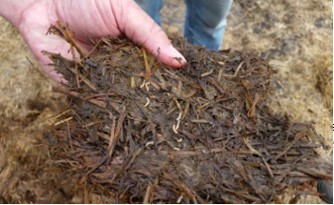
Photo: Rotting hay is a breeding ground for stable fly
The best way you can stop stable flies from impacting people, pets and livestock is to maintain regular hygiene practices at your property and remove/treat organic material.
If you have the control measures in place to stop stable fly breeding you can reduce numbers of adult stable flies by:
- placing a white sticky trap, near to livestock, horses or other host animals,
- using insecticides and repellents.
Protective measures such as tassels and rugs can also reduce the likelihood of horses being bitten by stable fly.
For information on using traps and insecticides see 'control options to protect livestock and pets'.
Information for the community, home and small-scale growers
Stable fly lay their eggs in soil containing rotting organic matter such as decomposing hay, remnant vegetable produce, and aged manure.
You may not realise that stable flies are breeding in the rotting organic material on your property because once the stable fly emerges from its pupae, it flies off in search of a blood feed.
By reducing any decaying organic matter or garden waste on your property you will be reducing the number of breeding sites available to stable flies.
- After you harvest any crops, turn off the water supply.
- Spread out any rotting organic material so it gets full sun and dries out.
- For any large pieces such as stumps, mulch at high speed or chop into smaller pieces.
- Once the organic material has dried out, combine it into the soil.
- Or you may choose to bury the waste in 1 m of soil.
- If the organic material gets wet, or if you notice any stable fly eggs, larvae or pupae, use an appropriate pesticide.
- Avoid accumulating piles of decomposing organic material, but if the piles are there temporarily (1 to 2 days), cover them to keep dry.
- Spread any animal manure, spilled feed and grass clippings into thin layers on the ground to dry out.
- If you feed reject vegetable produce to grazing animals, feed in a thin line, in a feed trough or on a concrete base, then remove any remaining fodder weekly and treat using the options above.
- Remove and treat any animal manure in and around pens, yards, water troughs, fences and gates weekly.
Some LGAs supply a Food Organics, Garden Organics (FOGO) bin collection service where you can place decaying matter and organic waste . If you do not have a FOGO bin, treat any organic waste by either burying it or using a combination of solarisation, mulching and pesticides.
Download our top community tips for managing waste which details all the steps you can take to reduce stable fly breeding on your property.
Note: If your property is located in an area where the stable fly is a declared pest, you must follow the control measures contained in the Stable Fly Biosecurity and Agriculture Management plan.
Stable flies mostly feed in the morning and again in the late afternoon when they can extract 5 times as much blood as a mosquito with each meal!
The fly will make several attempts to feed, adding to the distress of an animal. Once settled on an animal, it takes 2 to 5 minutes to complete the blood meal, after which it seeks a shady place to digest it.
The best way you can stop stable flies from impacting people and pets is for the community to maintain regular hygiene practices and remove organic material. If you have followed all the hygiene strategies in our top tips document, contact your local government authority and ask them to investigate the source of this infestation.
If you already have these measures in place, you can:
- Place a vertical stable fly sticky trap (either commercial or homemade) on your property
- use insecticides and repellents for temporary relief.
See ‘stable fly control options’ for additional information on using traps and insecticides.
Additional information
Control options
The best way you can stop stable flies from impacting people and pets is for the community to maintain regular hygiene practices and remove organic material. If you have followed all the hygiene strategies, contact your local government authority and ask them to investigate the source of this infestation.
If you already have these measures in place, you can:
- Place a vertical stable fly sticky trap (either commercial or homemade) on your property.
- Use insecticides and repellents for temporary relief.
Chemical control
Repellents do not kill the flies but can stop them landing on and biting the host. Most repellents only last several hours, so they will need to be reapplied regularly. Stable flies can also build up a tolerance to chemical control, so it is best to rotate through 3-4 different repellents every day.
- Animal bedding can be rinsed in a permethrin-based solution to deter the flies.
- Animal’s ears can be protected by applying oil-based creams or repellents such as Vaseline, Nature’s Botanical Crème (contains rosemary and cedarwood oils and is effective to deter stable flies but needs reapplying.
Insecticides are designed to kill the stable fly and include animal backline pour-ons (backline drenches) and insecticide-impregnated ear tags for livestock. If treating livestock with insecticide, application to the lower legs and underbelly of the animals is critical. Only use a pesticide approved for use by the Australian Pesticides and Veterinary Medicines Authority.
You can also apply residual sprays to surfaces used by stable flies when they are resting (e.g. shady surfaces, fences, walls). When the fly rests on the surface it absorbs the residue. Alternatively, you can make a cloth target treated-trap. These are effective for 1 to 2 weeks, but rain, high temperatures, and sunlight reduce the residual effect.
Cloth target treated trap
A cloth target treated trap is a white cloth soaked in insecticide that attracts, then kills stable flies. These traps can be effective for up to 3 months, particularly if the cloth is kept dry and taught between the 2 posts. However, keep animals away from the cloth.
To construct a cloth target treated trap:
- Soak the cloth in either 0.1 % solution of lambda-cyhalothrin or other pyrethroid/permethrins and let it dry on a flat surface.
- Prior to securing it tightly between two posts/star pickets, the bottom of the cloth trap should be no more than 0.5 m above ground level and be clear of vegetation.
- Alternative insecticides include bifenthrin, cyfluthrin, tetramethrin, deltamethrin, permethrin.
Stable fly traps
Commercial or home-made sticky fly traps can help to reduce fly numbers in local situations. White boards with a sticky surface will attract them, as they are likely to rest on a cool, vertical surface after a blood meal.
Ordinary protein-based traps do not attract stable fly but are effective against houseflies, blowflies and bushflies.
The simplest stable fly trap can be made, with a white board and a non-drying glue applied to the surface to catch the flies.
Follow the simple steps in our information sheet to make your own sticky trap.
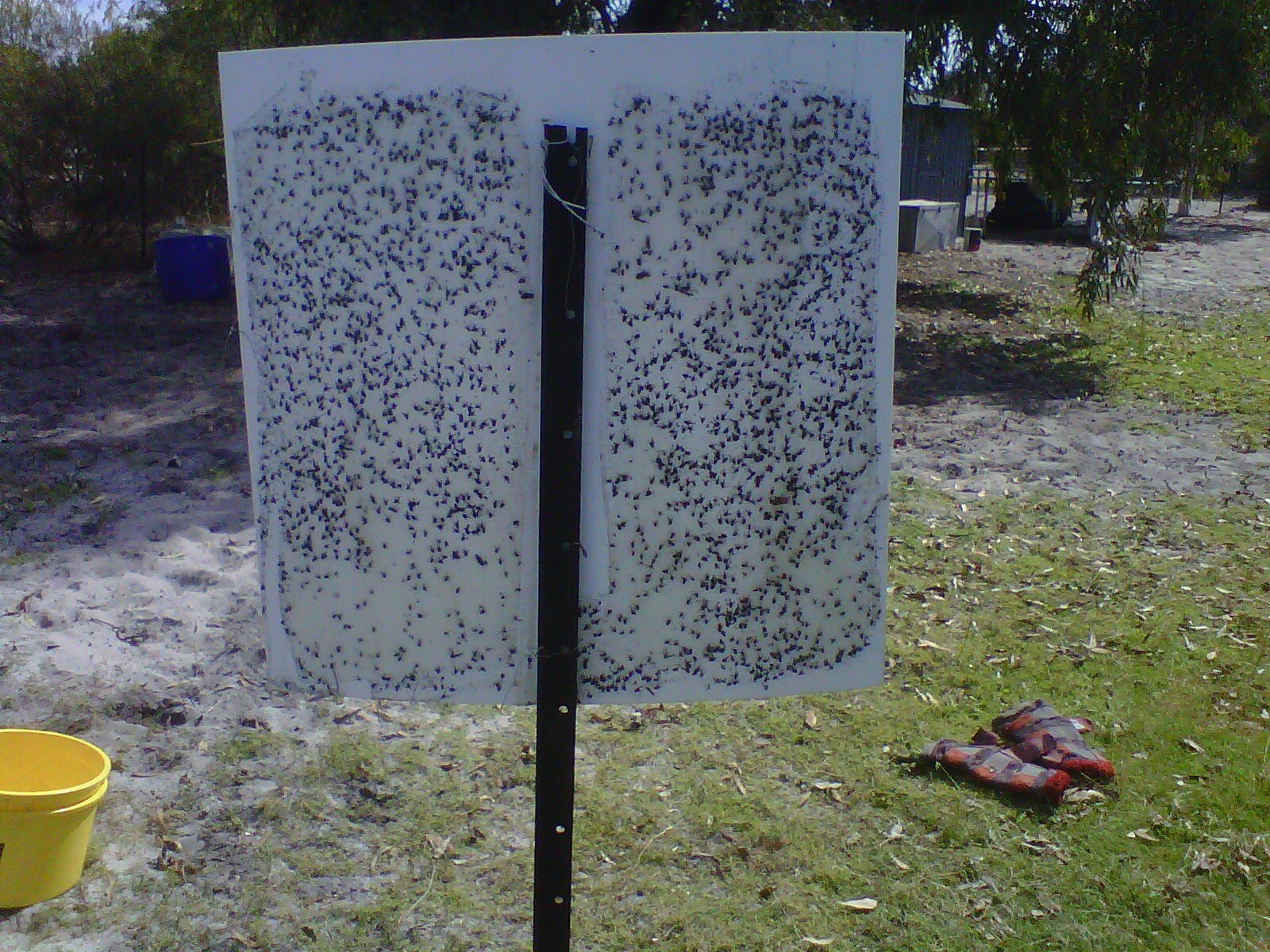
Photo: Home-made stable fly sticky trap
Commercial sticky traps
You can also purchase refillable commercial sticky traps for biting flies. Ask at your local produce store or do an internet search. Not all US suppliers may ship to Australia, so check first.
Small, commercial traps are easy to handle and dispose of when full of flies. Examples include Farnam Bite Free Stable Fly Trap, Starbar Bite Free Stable Fly Trap and EZ Sticky Fly Trap.
- 'Olson Traps' consist of an alsynite cylinder covered with a disposable, sticky clear film. The traps (cylinder plus stake plus 2 sticky sleeves) are available with 10 replacement sticky films.
- Aeroxon Barn & Stable Fly Catcher is a large roll of sticky tape (20 cm x 1 m) for hanging in barns, stables and kennels (available from biconet.com)
- 7 m flycatcher sticky rolls
Fasten the trap to a fence post or a stake pushed into the ground.
Remove and replace the films when covered with stable flies and/or dust.
Stable fly is often confused with the common housefly (Musca domestica) and bush fly (Musca vetustissima).
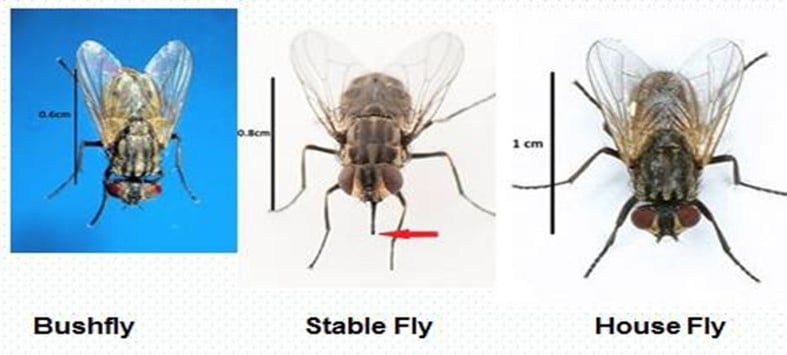
Photo: Comparison of the stable fly, bushfly and housefly
- It is slightly smaller than a house fly and slightly larger than a bushfly.
- has a checkerboard of dark spots on the back of the abdomen
- has a prominent black proboscis that is used to pierce the skin and draw blood.
Stable fly lifecycle
The lifecycle from egg to adult is about 13 to 18 days in temperatures ranging from 24°C to 30°C. At lower temperatures (10 to 20°C), such as those likely to be experienced over winter, development can take 3 to 5 months.
After ingesting a blood meal, the female fly lays around 90 eggs in 4 or 5 suitable locations, such as rotting vegetable matter or animal manure. She may lay up to 600 eggs over a lifetime and in warmer areas may breed year-round.
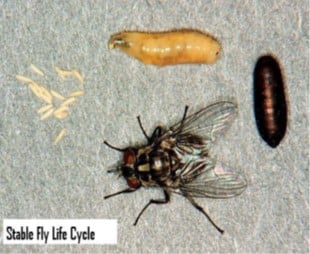
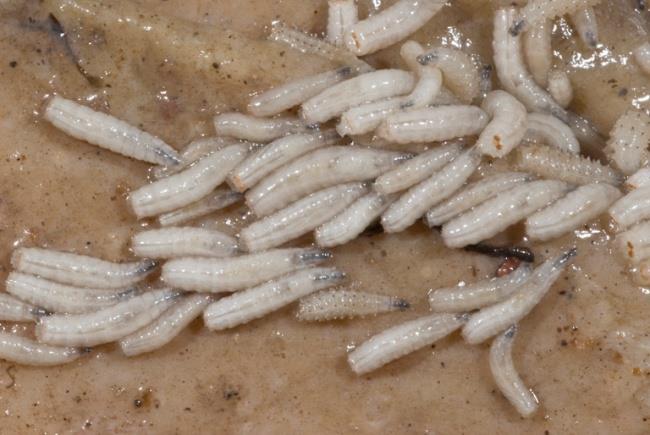
Photo: Stable fly lifecycle with eggs, larve and pupa and newly hatched larvae
In summer, the eggs hatch in as little as 20 hours and the active larval stages, which are extremely heat-tolerant, begin feeding for up to a week before pupating. The red-brown to black pupae are the size of a grain of rice, and can take as little as 5 days to emerge at high temperatures, or up to 30 days at lower temperatures.
After emergence, the adult flies disperse, sometimes covering up to 20 kms in search of a host animal. Both male and female adult flies feed on blood, as soon as 6 hours after emergence.
The adult flies live for about 3 to 4 weeks, with extreme heat (over 35°C) reducing their lifespan to just 2 weeks.
You can check to see if stable fly is breeding on your property by looking in any moist, decaying organic matter.
Stable fly larvae are usually found where rotting vegetable matter meets the soil. They are pale yellow to creamy white in colour and shaped like a cigar.
To locate them: look inside rotting vegetable root stumps, such as celery, cauliflower, or broccoli, or where organic material is in contact with the soil.
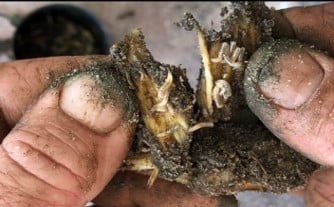
Photo: Stable fly larvae in rotting celery
When disturbed, the larvae will move away from the light but it may feign death for up to 30 seconds before moving.
Pupae are reddish-brown and barrel-shaped and are typically found in drier soil beneath or near decomposing organic matter. To find pupae, scrape through the soil to a depth of 5–10 cm and sideways about the same distance.
The best way to stop stable flies from breeding is to manage where their larvae grow by removing decaying organic material or turning off irrigation where there is rotting organic matter on the soil.
See our top community tips to control stable fly breeding on your property.
If you find stable fly larvae, only use a pesticide approved for Use by the Australian Pesticides and Veterinary Medicines Authority.
Report any stable fly infestations to your local government authority.
Documents
- Stable fly management FAQs (806 KB)pdf
- Management strategies for vegetable growers to control stable fly (299 KB)pdf
- Vietnamese: Management strategies for vegetable growers to control stable fly (456 KB)pdf
- Vietnamese: Stable fly management FAQs (917 KB)pdf
- Top community tips to control stable fly (558 KB)pdf
- Make your own stable fly trap (472 KB)pdf
- Pesticides and insecticides registered for stable fly control (812 KB)pdf
Good waste management is crucial to stop stable fly from breeding, to protect our community and animals.

